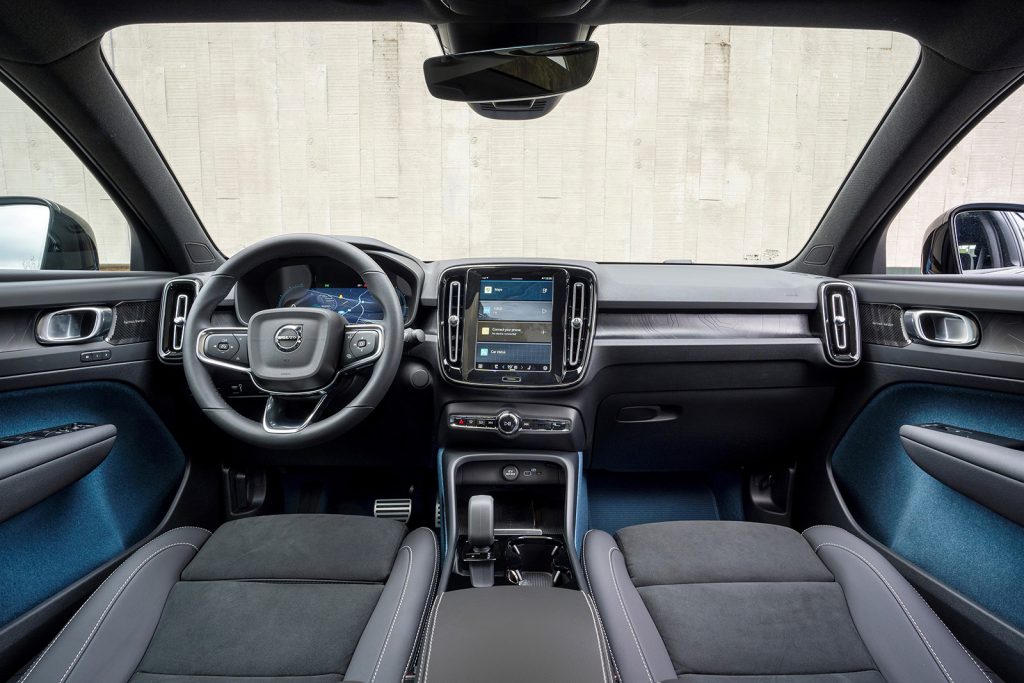Cargazing
By Derek Price
Volvo claims the C40, its first vehicle developed exclusively for an all-electric powertrain, points to a bright, battery-powered future.
Based on my weeklong test drive, that future could be equal parts serendipitous and frustrating.
On the bright side, there are some great things about driving an electric car — including a lot more than the claimed Earth-friendly ethos. The C40 is almost unbelievably quick thanks to 402 horsepower and a lightweight body that make it accelerate like a Detroit muscle car, albeit without the rumbly noise.
It has a brilliant digital interface designed by Google that runs the Android operating system, making the car’s screens act somewhat like a smartphone.
Volvo had already created one of the best in-house interfaces for cars, called Sensus Connect, but dumped it in favor of this Google system in the C40 because it’s even better than what Volvo’s team had built. That’s bold, and it’s the kind of thing I wish more car manufacturers did: leave digital design to the digital experts so car companies can focus purely on the car itself.
In the C40’s case, that shows off just how brilliant Volvo’s designers are.

The new C40 is Volvo’s first car developed exclusively for an electric powertrain. It’s very similar to the XC40 but with a more stylish, sporty roofline.
This vehicle gets a lot of the logical things right, including the extensive safety and self-driving features that are as sophisticated and simple to use as any car for sale today. It makes great use of the interior space and lays out all the controls in a practical, easy-to-understand way, which wasn’t always the case for Swedish cars.
Perhaps more importantly, it also inspires some emotion.
The C40’s body is gorgeous, even prettier than its closely related but boxier XC40 sibling. A sharply sloping roofline in back gives it terrible rear visibility and cuts into the storage volume, but who cares when it looks this pretty?
The interior continues the same theme. Its materials were all chosen for having a small impact on the environment but designed to create a cool, calming, classically Nordic impression. It’s proof that cars new can create a luxurious cabin in a sustainable way, without the traditional overuse of leather and petroleum products.
I love the fact that Volvo was able to take those bold, somewhat polarizing choices for the C40 in its design studio.
This car’s high seating position is also a love-it-or-hate-it feature. Personally, I’m on the hate side. I wish the seats were positioned lower, closer to the floor, to make you better sense its immense speed and cornering capability. It drives like a sports car in some ways, but the kitchen-chair-like seating position makes it feel anything but sporty.
It does provide great forward visibility, though. People who like the “king of the road” sensation in an SUV will love the C40, a small SUV that feels like a bigger one from the driver’s seat.

The C40’s cabin is designed using sustainable materials, including leather substitutes that feel sumptuous.
As much as I liked the performance and design of this new Volvo, I found the experience of living with it to be anything but smooth. To be fair, that’s not Volvo’s fault. Any electric car will have the same problems because EVs are currently selling faster than the infrastructure in the United States can keep up.
Using an electric car for long road trips, or even some regional trips, requires DC fast chargers to get to your destination and back. There aren’t nearly enough of those available. It felt like I spent half my busy week either waiting on DC chargers to become available or driving to charging stations that turned out to be broken, an infuriating problem that kept repeating itself.
This is a common issue for electric cars and will continue to be the case until massive numbers of fast chargers can be installed.
For shorter local trips, though, an EV makes perfect sense, especially if you have a Level 2 charger installed in your garage.
The C40 is a great example of the electric-vehicle selling points. It’s silent, comfortable, cheap to operate and responds with an instantaneous kick every time you press the accelerator.
The federal government rates its range at 226 miles.
Pricing starts at $55,300 for the C40 Recharge. It’s essentially the same vehicle as the XC40 Recharge, which is priced $1,750 cheaper but lacks the C40’s more stylish, coupe-like roofline.
Put another way, you can get more cargo space, better visibility and leave more money in your pocket by choosing the XC40, but it doesn’t look as cool.
If you want a sportier driving experience and even more emotional styling, Volvo’s all-electric Polestar brand is also worth considering.
At A Glance
What was tested? 2022 Volvo C40 Recharge Twin Ultimate ($58,750). Options: Metallic paint ($695). Price as tested (including $1,095 destination charge): $60,540
Wheelbase: 106.4 in.
Length: 174.8 in.
Width: 73.7 in.
Height: 62.8 in.
Motors: Front and rear with 78 kWh battery (402 hp, 486 lbs. ft.)
Estimated Range: 226 miles
RATINGS
Style: 9
Performance: 7
Price: 5
Handling: 6
Ride: 6
Comfort: 7
Quality: 7
Overall: 7
Why buy it?
The C40 wraps a strong all-electric drivetrain in cool Scandinavian style. It looks sleeker than the XC40 and has a wonderfully designed digital interface from the genius team at Google.
